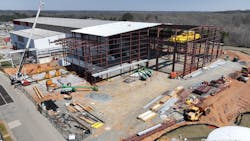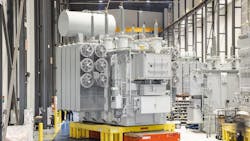The world is amid an energy super cycle with the energy industry facing a convergence of pressures and possibilities. As artificial intelligence (AI) continues to expand its reach, data centers are multiplying and growing – and with them, a new level of energy demand is emerging. At the same time, transportation and industrial sectors are undergoing rapid electrification. The compound effect is intensifying demand not only for energy, but for the infrastructure that makes electricity flow.
For transmission and distribution leaders, the question is no longer if the grid needs to scale – but how fast and how far. At the center of this transformation are transformers: the workhorses of the grid, supporting the expansion of high-voltage transmission, increases in grid reliability and resiliency, and large-scale integration of new, renewable energy sources. And right now, the industry is urged to address tomorrow’s energy challenges.
Also, over the past few years, demand for transformers and related components has grown at a rate that few could have anticipated with lead times having become a top concern for utilities and developers alike. As a result, manufacturers are not only increasing output but rethinking how to scale production in a more resilient and collaborative way.
As the world’s largest transformer manufacturer, Hitachi Energy is working to address those challenges and meet current and future demand – by working with stakeholders, coordinating with suppliers, and implementing one of the industry’s largest investment programs. Through its strong technological heritage and collaboration, the company connects people and innovation, building on its proven expertise, to deliver top-notch solutions that can contribute to powering sustainable energy for a harmonized society.
Global and local investments
Hitachi Energy’s response has been to act quickly and at scale. In 2024, the company announced a $6 billion USD global investment program, including $1.5 billion USD specifically to expand transformer production capacity. In March 2025, that was followed by the announcement of an additional $250 million USD investment through 2027 to ramp up the production of critical transformer components such as bushings and tap-changers, and insulation. More than 40 percent of this investment is focused on the United States. This work complements ongoing expansion activity at Hitachi Energy’s transformer facilities in Virginia, Missouri, Mississippi, and Tennessee where the company is investing in new equipment and technology and also creating hundreds of new jobs to help increase capacity and strengthen local supply chains.
Highlighting the importance of the investments, Bruno Melles, Managing Director of Transformer Business, Hitachi Energy, said: “Our investments to expand capacity, R&D and innovation, are helping us accelerate the delivery of transformers and components and fulfill our responsibility by helping the industry scale up to deliver critical infrastructure projects. By leveraging our global footprint, transformer technology and the expertise of our people, we are meeting the global demand for sustainable energy solutions.”
Hitachi Energy’s transformer portfolio supports every link in the energy value chain – from generation and transmission to distribution and end use, it serves a wide range of applications, including data centers, marine, rail, solar and wind power, and traditional sectors like oil, gas and chemicals.
Having also the world’s largest transformer installed base; Hitachi Energy is in a unique position to lead this next phase of infrastructure expansion. With the industry’s broadest portfolio of transformer insulation and components, and a presence that spans more than 60 manufacturing facilities and 30 service centers worldwide, the company plays a pivotal role in supplying both utility and original equipment manufacturer (OEM) customers. Its position at the center of the transformer ecosystem gives it the reach and flexibility to respond to shifting regional needs while supporting the global supply chain as a whole.
These actions are meant to do more than just meet rising demand. They’re part of a broader effort to bring greater transparency and predictability across the supply ecosystem. With hundreds of companies involved in the transformer value chain, a coordinated approach is essential to minimize delays and cascading bottlenecks.
A broader strategy to support the grid
The demand for transformers is more than a cyclical spike; it reflects a longer-term, structural shift in how power is generated, delivered, and consumed. As more renewable sources come online, grid interconnections increase, and electrification continues across industries, transformers become even more central.
Meeting this demand is not simply a matter of producing more units – it requires system-wide changes across the supply chain. That includes working closely with suppliers of key components, investing in digital tools and automation, and rethinking how lead times and procurement cycles are managed.
Transparency has become a key enabler. That’s why Hitachi Energy and others in the sector are working to share long-range capacity plans with partners and customers, giving them better visibility into what’s possible and when. These changes are helping utilities and developers make informed decisions as they plan for transmission upgrades, renewable interconnections, and new industrial loads.
Planning for long-term collaboration
Ultimately, infrastructure development at this scale cannot rely on reactive processes. It calls for new forms of collaboration between OEMs, utilities, developers, and policy makers. Hitachi Energy is engaged in long-term planning discussions with customers and partners, including establishing capacity reservation agreements and multi-year delivery strategies that provide the certainty needed for project execution.
Traditional lead times, procurement practices, and project timelines were not built for today’s energy realities. But the energy transition is moving quickly, and the industry must keep pace. Expanding manufacturing capacity is just one aspect of the equation. Building a more resilient, responsive infrastructure system will require coordination, innovation, and shared commitment across the value chain.
The moment calls for a shift – not just in technology or volume, but in the way we plan, partner, and deliver. The grid of the future is taking shape now, and it will be shaped by the decisions we make today.


